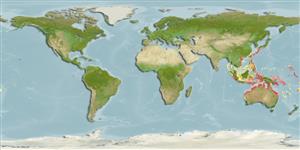>
Eupercaria/misc (Various families in series Eupercaria) >
Labridae (Wrasses) > Bodianinae
Etymology: Choerodon: Greek, choiros = a pig + odous = teeth (Ref. 45335); referrring to the prominent anterior canines of the species in this genus (Ref. 116605).
More on author: Richardson.
Environment: milieu / climate zone / depth range / distribution range
Ekologi
laut berasosiasi dengan karang. Subtropical
Indo-West Pacific: Western Australia to Queensland. Reported to range from Sri Lanka to Papua New Guinea, north to the Ryukyu Islands, south to New Caledonia (Ref. 9710).
Size / Weight / umur
Maturity: Lm ? range ? - ? cm
Max length : 70.0 cm TL jantan/; (Ref. 2334)
Duri punggung (Keseluruhan (total)): 13; duri punggung lunak (Keseluruhan (total)): 7; Duri dubur 3; Sirip dubur lunak: 10. Body with about 5 very faint broad dusky bands dorsally on side in most freshly preserved specimens. A large pale spot often present below posterior end of caudal fin in adults. No darky spot present on side below fifth or sixth dorsal-fin spine. Adults with second prominent anterior canine approximately same size as first, second canine slanted dorsally. (Ref 9823)
Adults inhabit sand and rubble areas of reef flats and flat shelf bottoms of outer reef slopes (Ref. 9710). They enter very shallow water, and feed mainly on mollusks. Oviparous, distinct pairing during breeding (Ref. 205).
Life cycle and mating behavior
Kematangan | Reproduksi, perkembang biakan | Pemijahan | telur-telur | Fecundity | Larva
Oviparous, distinct pairing during breeding (Ref. 205).
Randall, J.E., G.R. Allen and R.C. Steene, 1990. Fishes of the Great Barrier Reef and Coral Sea. University of Hawaii Press, Honolulu, Hawaii. 506 p. (Ref. 2334)
Status IUCN Red List (Ref. 130435)
ancaman kepada manusia
Harmless
penggunaan manusia
Akuarium: Komersial
informasi lanjut
AcuanBudidaya airprofil budidaya airStrainGenetikaElectrophoresesDiturunkanPenyakit-penyakitPengolahanNutrientsMass conversion
mitraGambarStamps, Coins Misc.Suara-suaraCiguateraKecepatanTipe renangArea insangOtolithsOtakPenglihatan / visi
Alat, peralatan
laporan khas
muat turun XML
Sumber internet
Estimates based on models
Preferred temperature (Ref.
123201): 24.6 - 29.3, mean 28.4 °C (based on 1845 cells).
Phylogenetic diversity index (Ref.
82804): PD
50 = 0.5000 [Uniqueness, from 0.5 = low to 2.0 = high].
Bayesian length-weight: a=0.01318 (0.00582 - 0.02984), b=3.05 (2.86 - 3.24), in cm total length, based on LWR estimates for this (Sub)family-body shape (Ref.
93245).
Trophic level (Ref.
69278): 3.6 ±0.50 se; based on food items.
Daya lenting (Ref.
120179): Rendah, Waktu penggandaan populasi minimum 4.5 - 14 tahun (Preliminary K or Fecundity.).
Fishing Vulnerability (Ref.
59153): Moderate to high vulnerability (48 of 100).
Nutrients (Ref.
124155): Calcium = 19.6 [9.5, 38.6] mg/100g; Iron = 0.484 [0.269, 0.903] mg/100g; Protein = 19.4 [16.5, 21.6] %; Omega3 = 0.19 [0.11, 0.33] g/100g; Selenium = 17.3 [8.7, 33.0] μg/100g; VitaminA = 47.5 [14.6, 188.4] μg/100g; Zinc = 0.759 [0.516, 1.245] mg/100g (wet weight);
